You're using an outdated browser. Please upgrade to a modern browser for the best experience.
Please note this is a comparison between Version 1 by René D. Peralta and Version 3 by Lluvia Azhalea Guerrero.
Gemini surfactants are dimeric structures, composed of two hydrophobic chains and two hydrophilic heads, linked by a spacer at or near the head groups. They present lower CMC, better efficiency to form micelles, and solubilization capacity comparedto their conventional (monomeric) counterparts. They can also reduce the surface tension of water and the oil–water interfacial tension from 10 to 100 times. This behaviour depends mainly on the nature of their components (heads, hydrophobic chains and spacer); thus, their synthesis is focused mainly on varying the type and length of these components.
- Gemini Surfactants
- Structure
- Applications
1. Structure
Gemini surfactants have attracted interest among the scientific community in various applications due to their very low CMC, greater solubilization power, as well as better wetting and foaming properties compared to single-chain surfactants [1][71]. Gemini surfactants have a polymorphic phase behaviour and a great variety of self-assembled structures forming aggregates that can be observed as micelles, bilayers, and vesicles, depending on the head groups, the size of the hydrophobic tails, and the nature of the spacer [2][72]. Figure 1 shows the structure of normal micelles obtained from conventional and gemini surfactants.
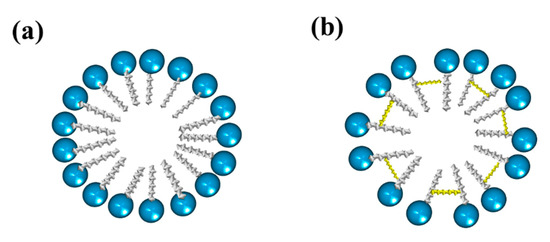
Figure 1. Representation of micelles formed from (a) conventional surfactants and (b) gemini surfactants.
2. Type of Gemini Surfactants
Gemini surfactants are classified by their physicochemical characteristics, groups present in the hydrophobic tails, and spacers. Regarding rigidity, the spacers in the chemical structure of a gemini surfactant can be classified into two subcategories, flexible (methylenes) and rigid (stilbene) (Figure 2a,b, respectively). Spacers also can be classified according to their length into short (Figure 2c) or long (Figure 2d). It is worth mentioning that the length of the spacer influences the geometry of the micelles. The presence of short spacers increases the repulsion between the head groups, resulting in micelles with a fiber-like structure, even at low concentrations of surfactant (Figure 3a). On the contrary, when the spacers are long, the micelles have elliptical geometries (Figure 3b). The transition from spherical micelles (Figure 3c) (4–8 carbon atoms in the spacer) to elliptical micelles occurs when repulsion between the groups of the polar heads decreases [3][73].
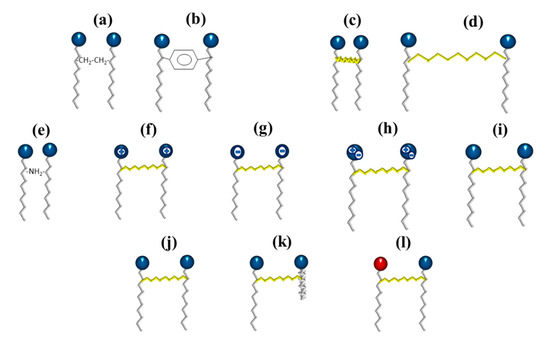
Figure 2. Schematic representation of the different types of gemini surfactants: (a) flexible spacer, (b) rigid spacer, (c) short chain spacer, (d) long-chain spacer, (e) polar spacer, (f) cationic, (g) anionic, (h) zwitterionic, (i) non-ionic, (j) two identical hydrophilic heads and hydrophobic chains, (k) two non-identical hydrophobic chains, and (l) two non-identical hydrophilic heads.
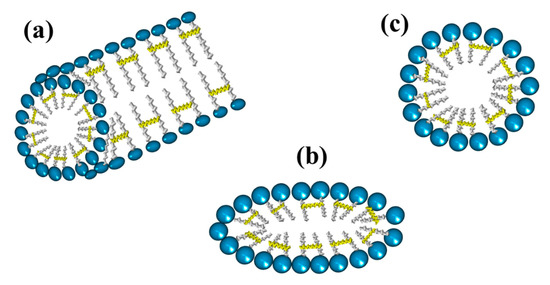
Figure 3.
Geometries of micelles from gemini surfactants linked by the tail: (
a
) fiber-like, (
b
) elliptical, and (
c
) spherical.
On the other hand, the groups present in the spacer can be classified into polar (Figure 2e) or nonpolar (aliphatic and aromatic groups). Furthermore, the polar head can be positive, negative, zwitterionic, or non-ionic (Figure 2f–i). Finally, gemini dissymmetric (heterogeminis) surfactants contain two groups of non-identical polar heads (or identical) and different (or identical) lengths of alkyl tails, so they can also be classified into gemini surfactants of different head or hydrophobic tails and gemini surfactants of identical head and hydrophobic tails (Figure 2j–l) [4][74].
The surface activity of heterogeneous surfactants is highly dependent on the degree of asymmetry. For pyrene-based asymmetric gemini surfactants synthesized in five-step reactions, the Krafft temperature increases as the alkyl chain length increases. Similarly, the CMC values are much lower than their symmetric counterparts [5][75].
3. Synthesis Pathways
There are three main routes to synthesize symmetric gemini surfactants (Figure 4): (a) reaction of long chain tertiary amines with dihalogenated substrates as organic dibromides or dichlorides; (b) reaction of N,N,N′,N′-tetramethylpolymethylene diamines with alkyl halides; and (c) reaction of long chain tertiary amines with a haloalkylene oxide substrate.
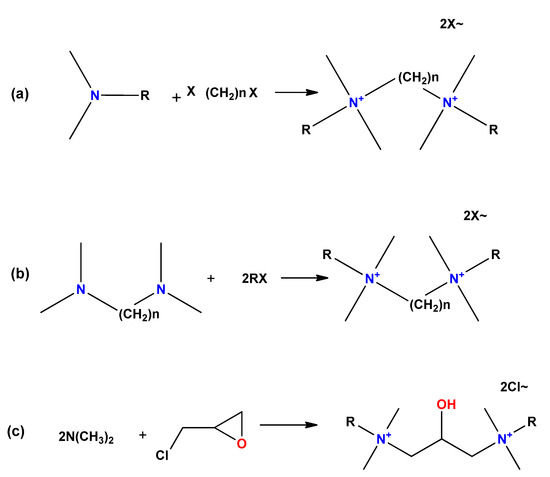
Figure 4. General routes to obtain gemini surfactants. (a) Reaction of long chain tertiary amines with dihalogenated substrates as organic dibromides or dichlorides; (b) reaction of N,N,N′,N′-tetramethylpolymethylene diamines with alkyl halides; and (c) reaction of long chain tertiary amines with a haloalkylene oxide substrate.
The yield of the synthesis of gemini surfactants depends mainly on the reactivity of the dihalogenoalkanes and the polarity and protic character of the solvent [6][76]. The best results have been achieved in aprotic and polar solvents. Some of these reactions can also be carried out without a solvent under mild conditions with very high yields [7][77]. Amino acid-based gemini surfactants are synthesized by condensation reactions at the amino group or the carboxyl group of the amino acid [8][78]. There are many studies on the synthesis and biological evaluation of gemini surfactants based on amino acids derived from arginine [9][79]. Some gemini surfactants have also been obtained from lysine, glycine, and cysteine [10][11][80,81]. Wang et al. synthesized a sugar-based gemini surfactant with a N, N′-acetylethylenediamine spacer (N,N′ (N-dodecyl-2-D-glucosaminyl acetyl) ethylenediamine and D-(+)-glucono-1,5-lactone as the starting material, in three steps. The CMC value (10−5 mol·L−1) determined by surface tension indicates a higher surface activity than the corresponding monomeric sugar-based surfactants [12][82]. With the aim of applying the surfactants in the oilfield, Hussain et al. [13][83] synthesized quaternary ammonium gemini surfactants with a different length of the spacer group (C8, C10, and C12), by solvent-free amidation of glycolic acid ethoxylate lauryl ether with 3-(dimethylamino)-1-propylamine. Similarly, Zhou et al. synthesized gemini surfactants in three steps using triethylene tetramine, fatty-acid methyl esters, ethyl chloride, N, N′-dimethyl ethylenediamine, and 3-chloro-2-hydroxypropane sulfonic acid sodium as the main raw materials to be applied in oilfields [14][84].
Thermodynamic and surface parameters are often evaluated for gemini surfactants. The effect of variations in the hydrophobic chain length of the gemini imidazolium surfactants on thermodynamic and surface parameters was studied by Ren et al. [15][85] (Figure 5). The results indicated that the micellization process could be both enthalpy and entropy driven, and that the increase in alkyl chain length causes the decreases in CMC and aggregation number.
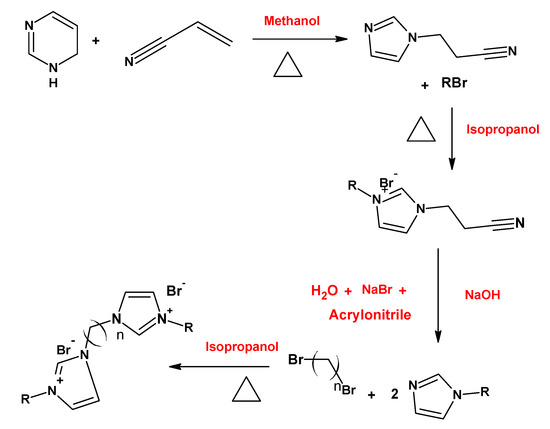
On the other hand, the synthesis and characterization of the anionic sulfonate gemini surfactants (Figure 6) with different hydrophobic chain length shows that this kind of surfactant presents a lower density, viscosity, and CMC than sodium dodecylbenzene sulfonate (SDBS), a monomeric surfactant with twelve carbon atoms in the hydrophobic chain [16][86].
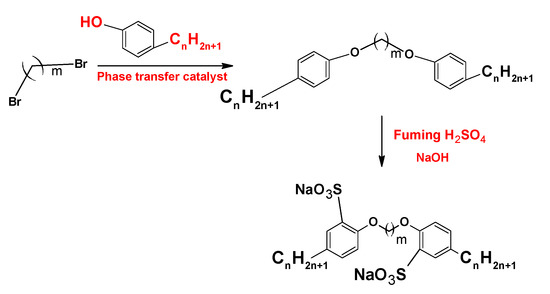
Figure 6. Synthesis of sulfonate gemini surfactants.
To improve the biodegradability of the cationic gemini surfactants, biodegradable moieties such as ester and amide groups have been used (Figure 7). It has been found that gemini surfactants are pH-responsive in alkaline conditions due to the ester group between the cationic head groups. The cationic gemini surfactants with an ester group in the spacer are more biodegradable than those with the ester bond in the tail [17][87].

Figure 7. Synthesis of gemini surfactants containing an ester group.
4. Micelles Formation
Gemini surfactants can produce aggregates such as micelles, bilayers, vesicles, and other structures with different additives [18][88]. Several authors have carried out recent studies related to the formation of aggregates from gemini surfactants due to the benefits of these surfactants compared to those with a single hydrophobic chain.
A study of the interaction of the drug amitriptyline hydrochloride and the gemini surfactant ethane-1,2-diyl bis (N,N-dimethyl-N-tetradecylammonium acetoxy) (14-E2-14) in three aqueous media showed the high ability of gemini surfactants to form spherical micelles in aqueous systems [19][89].
Yang et al. studied the properties of different gemini surfactants synthesized with different sizes of hydrophobic chains [20][90]. During the analysis, they found that the size of the aggregates formed by the surfactants increased when the surfactant concentration was raised, reaching sizes from 200 to 400 nm. In the case of studies using the transmission electron microscopy (TEM) technique, surfactants with hydrophobic chains of 12, 16, and 18 carbon atoms formed spherical groups of hundreds of nanometers in solution with a tendency to form spherical aggregates.
In 2017, Feng et al. synthesized gemini alkyl glucoside surfactants to develop vesicles using (+)—catechin (C) and (−)—epigallocatechin (EGC) laureate, finding that the thermal stability of C or EGC was improved due to the encapsulation in more ordered structures. In addition, the incorporation of these drugs at low concentrations strengthened the bilayer formed [21][91].
In 2018, Gan et al. reported the formation of vesicles and micelles from gemini surfactants based on glucono-δ-lactone, which depended on the length of the hydrocarbon chain as well as the surfactant concentration [22][92].
In addition, there are studies on the influence of some parameters, such as the concentration, pH, temperature, and the presence of salts, on the morphology of aggregates formed by cationic gemini surfactants. These studies have shown a change from micelles to vesicles and vice versa by varying either the pH or temperature. Furthermore, the presence of salts may cause a transition from vesicles to micelles (Figure 8) [23][93].
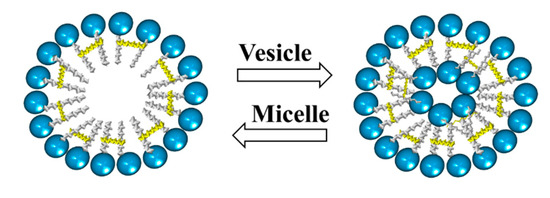
Figure 8. Scheme of transition from micelles to vesicles and vice versa.
More recently, Asadov et al. synthesized and characterized the cationic gemini surfactant N,N′-bis(alkyl)-N,N′-bis (2-hydroxypropyl) ethylene diammonium dibromide with chain lengths of 9, 12, and 14 carbon atoms [24][94]. They found that the aggregate diameters decreased when temperature was increased. In another work, Rajput et al. studied the effect of the addition of diclofenac sodium to gemini surfactant micellar aggregates, reporting a transition from micelles to vesicles as a result of an increase in the drug:gemini surfactant molar ratio. They claimed that the stability of vesicles at the human body temperature also makes them candidates for use in drug release [25][95].
5. Applications
Gemini surfactants have found application in medicine, physics, optics, and electronics. Polymerizable gemini anionic surfactants also have been synthesized to improve its interfacial properties [26][96]. These surfactants have been used as a template for the synthesis of nanoparticles. Tiwari et al. described the preparation and characterization of gold, silver, and gold-silver alloy nanoparticles using gemini surfactants as stabilizers of the nanoparticles around metal surfaces [27][97]. In addition, gemini surfactants have been used to obtain supramolecular solvents (SUPRAS), which are nanostructured liquids formed by aggregates of surfactants obtained through a self-assembly process. This type of solvent is assigned mainly to microextraction methods with applications in the cosmetic industry [28][98]. On the other hand, the formation of a spatial network of well-dispersed molecules is very important for biomedical and optoelectronic applications and these surfactants have been effective to form a three-dimensional network with supramolecular micellar hybridization [29][99]. Furthermore, these surfactants have been used as stabilizers in enhanced oil recovery [30][100]. For applications in this field, sulfonates gemini surfactants were shown to reduce the oil–water interfacial tension to ultralow values, around 10−3 mN/m, with surfactant concentrations less than 0.5 wt % [31][101]. Another important parameter for applications in oilfields, is thermal stability. In this sense, Hussain et al. studied the thermal degradation of three cationic poly(ethylene oxide) gemini surfactants containing flexible and rigid spacers. The thermal gravimetric analysis showed a degradation temperature higher than that observed in an oilfield (90 °C) [32][102].
In the polymer area, gemini surfactants play an important role in the synthesis of hybrid systems based on surfactant-polymer materials that have different applications. Hussain et al. investigated the properties of a surfactant-polymer hybrid material as candidate for carbonate reservoir at high temperatures [33][103]. They studied how the spacer length of the surfactant affects the rheological properties of the surfactant-polymer solutions. Furthermore, nanoemulsions stabilized by a gemini surfactant (14-6-14 GS) have been reported [34][104]. In the polymerization, Dreja and Thieke [35][105] reported the polymerization of styrene by free radicals at 25 °C in oil-in-water microemulsions stabilized by a series of cationic dimeric (gemini) surfactants and initiated by 60Co-γ-radiation. The resulting polymeric dispersions contained spherical latex particles (30–60 nm average diameter) and their size could be controlled by the monomer/surfactant ratio as well as by the surfactant spacer length. The polymer weight average molecular weight varied from 0.164 to 1.400 × 106 Da and depended on the spacer length and crosslinking. In a more recent study, Wang et al. [36][106] synthetized six quaternary ammonium salts from cardanol, a renewable resource, that can perform as gemini reactive surfactants. The surfactants, with a spacer consisting of a saturated aliphatic hydrocarbon chain, had a CMC of ≤0.2 mmol·L−1. A photo-active gemini surfactant with CMC = 0.05 mmol·L−1 was the stabilizer of a methyl methacrylate (MMA) emulsion, which was successfully polymerized using 2,2′-azobisisobutyronitrile as the initiator. Additionally, the gemini surfactant containing benzyl bromide was used as initiator and emulsifier during the atom transfer radical polymerization. The polymer obtained contained a cardanol-end unit and had an Mn = 45.1 kDa.
Regarding the use of gemini surfactants in the biomedical area, the research of Cardoso et al. studied the effectiveness of complexes of serine-derived gemini surfactants and DNA in mitochondrial expression [37][107]. For their part, Faustino et al. reported the synthesis of gemini anionic surfactants from L-cysteine, D-cysteine, DL-cysteine, and their monomeric counterparts (Figure 9a,b), as well as the study of their properties in solution at physiological pH. GIn this work, gemini surfactants showed low CMC values and higher efficiency than their monomeric counterparts. Furthermore, surfactants were found to interact with bile acids, membrane phospholipids, oligosaccharides, and bovine serum albumin protein [11][81]. Furthermore, it has been reported that the solubilization of the drug amphotericin B (AmB) in micelles formed with an anionic gemini surfactant (derived from the amino acid cysteine) prevents self-aggregation of the drug, which makes it less toxic during administration (Figure 9c). In addition, the use of gemini surfactants avoids organic solvents, often used in the preparation of other drug carriers such as polymeric micelles, liposomes, and nanoparticles [38][108].
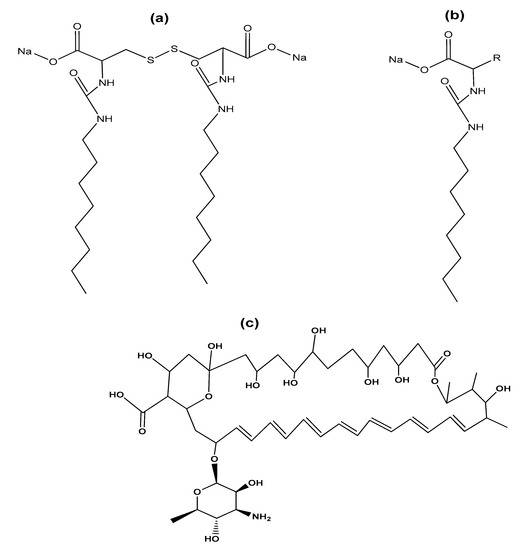
Figure 9. (a) Anionic gemini surfactant derived from cysteine and (b) its monomeric counterpart; (c) chemical structure of antifungal polyene antibiotic amphotericin B.
Specifically, in drug delivery, Cruz et al. used cationic gemini surfactants to deliver RNA for gioblastoma treatment [39][109], while Michel et al. developed a cationic gemini surfactant modified with β-cyclodextrin to improve the biological and physicochemical behavior of the drug mephalan. [40][110]. There are some reports on the use of amino acid-derived gemini surfactants for drug delivery; in this regard, lysine-derived surfactants have been used to form niosomes as delivery systems for the parenteral administration of the anticancer drug methotrexate [41][111]. Srivastava et al. developed gemini surfactant vesicles for encapsulation and release of the anticancer drug doxorubicin. They found that vesicles reduce the toxicity and showed better therapeutic effects at high drug concentrations [42][112]. Recently, Choi et al. synthesized disulfide-bridged gemini surfactants and their micellar properties were analyzed in the release of drugs for reactive oxygen species. The self-assembled surfactants as stable micellar aggregates were subjected to a reductive environment that caused destabilization of the micelles, suggesting that this response of the micelles could be used in the release of anticancer drugs [43][113].
On the other hand, one of the properties of gemini surfactants that allows their uses in medicine is their antimicrobial activity, for example, against Gram-positive bacteria such as Bacillis subtilis and Staphylococcus aureus [44][114]. This property makes them good capping agents for metal nanoparticles synthesis with unique and strengthened biocidal properties [45][67].
Cationic gemini surfactants have also found application as corrosion inhibitors (Figure 10) [46][115] and in the area of environmental protection, for example, in soil remediation to remove hydrophobic organic pollutants, heavy metals, and radionuclides from the soil [47][116].
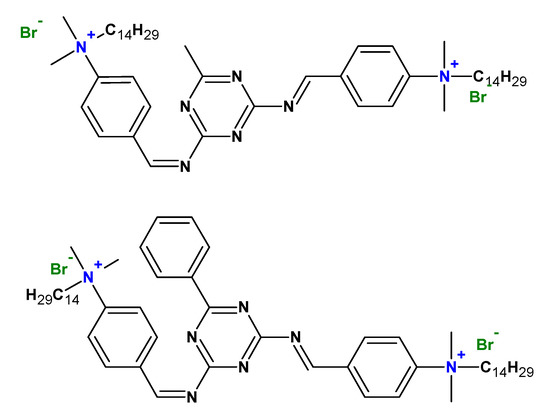
Figure 10. Chemical structures of some gemini surfactants used as corrosion inhibitors.
Otherwise, the study of the interactions between proteins and surfactants is very important due to the numerous technical applications in the fields of pharmaceuticals, cosmetics, paints, coatings, etc. [48][49][50][51][117,118,119,120]. Surfactants can cause the protein conformational changes via electrostatic and hydrophobic interactions, leading to the protein folding or unfolding depending on the concentrations of surfactants and proteins [52][53][54][121,122,123]
Recently, gemini surfactants were shown to be more efficient to interact with proteins by comparing them with single-chain surfactants [55][56][57][58][124,125,126,127]. Zhou et al. studied the effect of the structure of cationic surfactants on the conformation of bovine serum albumin (BSA) with a series of imidazolium gemini surfactants. The results showed that the gemini surfactant with either a shorter spacer or longer chain has a larger effect on BSA unfolding, and that the interactions of BSA with imidazolium gemini surfactants are stronger than those for single quaternary ammonium surfactants [59][128]. For their part, Branco et al. studied the interaction between a cationic amino acid-based gemini surfactant derived from cysteine and BSA under physiological conditions [60][129].
Luo et al. focused on the investigations of the interactions between single-chain or gemini quaternary ammonium surfactants with hemoglobin. They observed that the interactions between the surfactants and hemoglobin were mainly caused by both electrostatic and hydrophobic interactions, and the hydrophobic chain length and linking group length of the surfactants had a significant influence on tuning the conformations of hemoglobin [61][130]. For their part, Amiri et al. reported the interactions of gemini surfactants with ribonuclease Sa, and the results indicated that the tune of protein conformations is changed with the structure of surfactants and proteins [62][131]. More recently, Aslam et al. reported the preparation of pyridinium-based gemini surfactants and the study of interaction with BSA. They found a strong interaction between the gemini surfactants and protein due to the decrease of the CMC of surfactant as the BSA concentration was increased [63][132].
Micellar catalysis is a process that consists of the accumulation of a catalyst in the internal part of a micelle [64][133]. The micellar catalysis was shown to improve the reaction rate between the oil–water interphase and selectivity of the target molecules in organic reactions, such as electrophilic and nucleophilic substitution, hydrolysis, etc. [65][66][134,135].
Micellar catalysis using gemini surfactants was shown to have high catalytic efficiency and accelerate processes reducing the generation of secondary reactions [67][68][136,137]. Bunton et al. proposed for the first time the use of gemini surfactants in micellar catalysis [69][138]. The gemini surfactant synthesized by this group showed better catalytic efficiency than CTAB in nucleophilic substitutions reactions. Since then, more studies have been reported [70][71][72][73][139,140,141,142]. Micellar catalysis using gemini surfactants has been applied in reactions of ester hydrolysis [74][143], chloromethylation [75][144], and nucleophilic and electrophilic substitutions [68][137]. Furthermore, the catalytic properties of these surfactants have favoured the development of aqueous micellar catalytic processes, where the substitution of organic solvents for water is achieved, contributing to the development of more sustainable and environmentally friendly processes [76][145].
